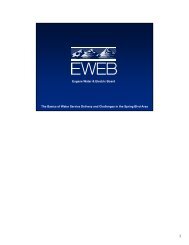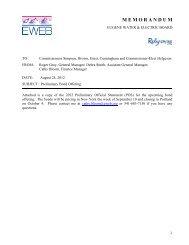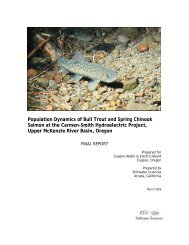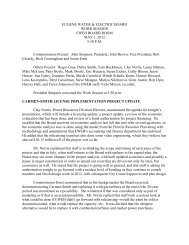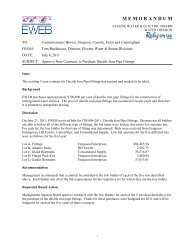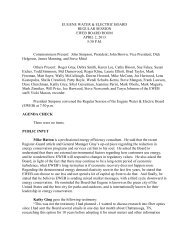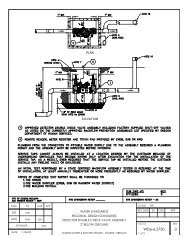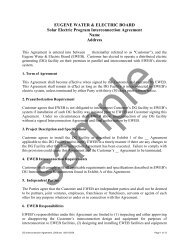Water Reliability Initiative - Eugene Water & Electric Board
Water Reliability Initiative - Eugene Water & Electric Board
Water Reliability Initiative - Eugene Water & Electric Board
Create successful ePaper yourself
Turn your PDF publications into a flip-book with our unique Google optimized e-Paper software.
The first step for developing a robust and multifaceted communications plan is gaining a realunderstanding of where the community, key stakeholders and potential partners stand on theissues: What level of trust do customers have for EWEB staff and policymakers? Do EWEB customers understand the need for a reliable system and a second source ofsafe drinking water? Are key stakeholders supportive of EWEB securing a second source? What value do theyplace on reliability? What are the leading issues for development of a second source? What information do policymakers and the community need to move the project forward? Can the community accept the Willamette River as a secondary source of water? Whatassurances are needed about water quality? Is there potential for a partnership approach with other water suppliers? What is the best way to communicate with customers and the community on this topic?Through the use of scientifically sound public opinion research – telephone survey, focusgroups, stakeholder interviews – and in close collaboration with EWEB staff, the Barney &Worth team has produced a communications plan that reflects community feedback andexpectations. The communications plan will help guide the water supply decision process.EWEB <strong>Water</strong> <strong>Reliability</strong> <strong>Initiative</strong> 2Communications Plan
Second Source of <strong>Water</strong>EWEB is the largest water provider in Oregon thatrelies on a single source of drinking water – theMcKenzie River. Although EWEB has emergencyinterties with neighboring water utilities, in theevent of an emergency these other watersuppliers do not have enough surplus water tomeet even a single day of <strong>Eugene</strong>’s waterdemand.Currently, on summer days EWEB has onlyenough emergency water storage to provide oneor two days of water if something happens to theMcKenzie River water source or EWEB’s watertreatment plant. A lack of a second source ofdrinking water could result in unacceptable publichealth and safety issues should a prolongedwater outage occur.The single source of supply also limits EWEB’sability to repair and upgrade critical water facilities– reservoirs and transmission lines – whilekeeping the water system on-line.Developing a secondary source of drinking wateris challenging. There are very limited local supplyoptions. Viable solutions are expensive andView of the Willamette River MiddleFork from Mt. PisgahEWEB needs to keep rates affordable for the community. With the challenges of the secondsource pursuit, the right answer has been sought for years.EWEB’s leadership is committed to moving ahead now to find an affordable way to develop asecond source of drinking water. Along with EWEB’s other reliability improvement projects, thedevelopment of a second source of drinking water will provide for the basic needs of the <strong>Eugene</strong>community and wholesale customers.EWEB <strong>Water</strong> <strong>Reliability</strong> <strong>Initiative</strong> 5Communications Plan
Communications Opportunities and ChallengesPublic Opinion ResearchEWEB has been working on improving the reliability of <strong>Eugene</strong>’s drinking water system for over100 years. Past efforts, such as expanding the water treatment plant and replacingdeteriorating pipelines, garnered little public attention. Developing a new source of drinkingwater as a reliability improvement will attract more interest from the community, andstakeholders expect they’ll have a chance to provide input in the decision process. EWEB iscreating a communications plan to ensure everyone is given an opportunity to become informedand engaged in the project. Public opinion research – including stakeholder interviews, atelephone poll of EWEB water customers, and two focus group panels – was conducted toinform the communications plan.What level of trust do customers have for EWEB staff and policymakers?EWEB is well respected and participants from stakeholder interviews, telephone poll andfocus groups consistently praise EWEB service and staff. Results of public opinion researchconfirm EWEB is the right entity to lead second source planning and decision making.Stakeholder interviews: Key communityleaders hold EWEB in high regard, almostunique among its local public agency peers.The organization is said to be professionaland well run, highly credible and trusted bykey stakeholders and the public, with a“EWEB has a positive publicimage: well-run, environmentallyresponsible, a goodcommunicator.”strong track record of environmental stewardship. EWEB staff members are “experts in theirfields,” and good communicators with the public, observers say. The EWEB <strong>Board</strong> is expectedby community leaders to take the lead in decisions on a second source.Telephone poll: Results of the telephone survey show more than 90% of customers aresatisfied with EWEB – a very high rating for any utility in the Pacific Northwest or nationally.Satisfaction with Drinking <strong>Water</strong> ServiceVery satisfied68%Somewhat satisfied24%Not too satisfiedNot at all satisfiedDon’t know3%1%4%0% 20% 40% 60% 80% 100%Source: DHM Research, April 2012EWEB <strong>Water</strong> <strong>Reliability</strong> <strong>Initiative</strong> 6Communications Plan
Focus groups: Participants praise EWEB for their excellent customer service, but havecomplaints about EWEB’s “palatial” headquarters and spending priorities.Do EWEB customers understand the need for a reliable system and a second source ofsafe drinking water?Most public opinion research participants, including stakeholders actively involved with EWEB,have little familiarity with the <strong>Eugene</strong> area’s current drinking water situation or the need for asecondary water source.Stakeholder interviews: When asked about the currentwater supply situation, without being given any furtherinformation, most key stakeholders conclude that EWEB’sdrinking water is abundant, of the highest quality, andaffordably priced. Facilities are functional and wellmaintained. There’s little awareness of water reliability issues.“There are nodeficiencies forprovision of good,clean water.”Telephone poll: Telephone survey participants’ awareness that the McKenzie River is<strong>Eugene</strong>’s only water source, and that an interruption could leave the area with only one or twodays of water supply is low. Six in ten respondents say they are not at all aware of thissituation.Awareness of Possible <strong>Water</strong> Source InterruptionVery awareSomewhat awareNot too aware11%16%14%Not at all aware57%Don’t know3%Source: DHM Research, April 20120% 20% 40% 60% 80% 100%Focus groups: Participants also have very little awarenessof the need for a second water source. More than half saythey are not at all aware that EWEB’s only water source isthe McKenzie River and there would only be 1 – 2 days ofsupply in case of an interruption.“Very surprising. Iwould guess veryfew residents areaware of this.”Are key stakeholders supportive of EWEB securing a second source? What value dothey place on reliability?When first introduced to the idea of a second source, the concept seems to “makes sense” tomost – a good “insurance policy” in case of an emergency. But on further consideration, mostparticipants have questions about the real need for a second supply and worry about the cost.EWEB <strong>Water</strong> <strong>Reliability</strong> <strong>Initiative</strong> 7Communications Plan
Stakeholder interviews: For some participants, the needfor second source reliability is urgent. They describe thesituation as an unacceptable risk: “Extremely important.”“It’s not good to have all your eggs in one basket!”. Forothers it is a risk that the community has been living withfor a long time, and they wonder why something has to bedone about it now: “It makes sense but it is not a pressing need”.Very important.People can’tsurvive withoutwater.”Telephone poll: Seven in ten telephone survey respondents say it is very or somewhatimportant that <strong>Eugene</strong> has a second source of water.Importance of Second SourceVery importantSomewhat important33%38%Not too importantNot at all importantDon’t knowSource: DHM Research, April 201213%10%6%0% 20% 40% 60% 80% 100%These results, however, do not translate into willingness to raise water rates to develop asecond source. When asked to pay, respondents are divided almost evenly with 46%supporting and 41% opposed. Opponents are more likely to feel strongly than supporters byabout a two to one ratio. The “don’t know” rate is also 13%, indicating greater uncertainty. Asthey hear more information on the topic, telephone poll respondents express less support andare more opposed to raising rates to develop a second source of drinking water.Support for Second SourceStrongly support9%Somewhat support37%Somewhat opposeStrongly opposeDon’t knowSource: DHM Research, April 201219%22%13%0% 20% 40% 60% 80% 100%Focus groups: Similar to the stakeholder groups and telephone survey respondents, focusgroup participants initially support development of a second source, but with further thoughtand discussion they start to weigh the costs and benefits of finding a second water source andseem less motivated to take action.EWEB <strong>Water</strong> <strong>Reliability</strong> <strong>Initiative</strong> 8Communications Plan
Although more than half of the participants say they would support a rate increase, theirsupport is tepid, despite not testing a specific dollar amount. Twice as many say they would“somewhat” support a rate increase than “strongly” support one.Together, the opinion research underscores customers’ reluctance to spend money on asecond source – even though they see its lack as a problem. EWEB will need to communicatea clear and compelling message about the current risks and anticipated benefits, and will bewell advised to pursue affordable solutions.What are the leading issues for development of a second source?The shared issue across all research participants is thecost of developing a second water source. The costissue appears to be linked to today’s hyper-sensitivityabout government spending at all levels. Observersemphasize a need to be clear about the urgency andbenefits of second source water to balance against thecost equation.“I do believe that developingan additional water source isimportant and appreciate thefact that EWEB is lookinginto it. However, I would liketo see EWEB find a way todo it without raising rates.”With cost the chief focus of stakeholders’ concern, it isinteresting that focus group participants are unclear about how much they currently spend onwater, or even what services they are paying for. One participant said her EWEB bill was$500 per month while another said EWEB should get out of the sewer business. Thisconfusion may relate to EWEB’s utility bill that includes City of <strong>Eugene</strong> charges for sewer andstormwater.A key difference between the results of stakeholder interviews, telephone survey and focusgroups: key stakeholders have more concern about second source supply options. Anotherdifference: EWEB customers do not think that “a second water source might encouragepopulation growth and development” is a good reason to oppose an additional source.Telephone survey and focus group participants say this is a poor or very poor reason tooppose. In fact, participants indicate that growing <strong>Eugene</strong>’s economy and providing jobsshould be a priority for the community.What information do policymakers and the community need to move the project forward?Almost everyone raises questions about the goals for EWEB’s second water source:• Why is a second source needed?• Why hasn’t EWEB developed a second source already?• What are the risks to the community of not having a second source? What is the actuallikelihood of needing to rely on it?• In case of an emergency or catastrophic event, will the second source be more securethan the McKenzie River?• How much will it cost and how much will rates increase?• Is the second source of water intended as a limited backup to handle short-termemergencies, or will it serve as a full-scale, redundant water supply source?• Will the second source serve EWEB alone, or also meet other communities’ needs?EWEB <strong>Water</strong> <strong>Reliability</strong> <strong>Initiative</strong> 9Communications Plan
Can the community accept the Willamette River as a secondary source of water? Whatassurances are needed about water quality?The McKenzie River is widely regarded as one of Oregon’s and the nation’s premier drinkingwater sources. Abundant, clean water from the “magical McKenzie” flows from mountainsnow and springs through a proactively protected watershed. It is carefully monitored andrequires “almost no treatment” (according to stakeholders).For the few stakeholders who are involved with EWEB or long-term water supply protectionand planning, <strong>Eugene</strong>’s other potential water sources are “second class”. Perhaps due to theMcKenzie’s excellent quality, reliability – and mystique – all other possible sources arethought to have drawbacks.This view is not shared by the general public. EWEB customers appear to be only moderatelyconcerned about the quality of the Willamette River; some assume they are already drinkingWillamette River water. More important to most customers is the project’s cost.Stakeholder interviews: For key stakeholders the McKenzie is far more desirable than anyother water supply source. There are varying degrees of concerns about the Willamette, andsome note the Willamette is a “fine source” and serves as the drinking water source fordownstream communities of Corvallis and Wilsonville. The supporters think EWEB hassufficient Willamette water rights; in their perception, this source is abundant and treatable.Telephone poll: When asked which of three sources they think would be the best secondsource, four in ten opt for the Willamette River. A quarter of participants prefer groundwaterwells and a high percentage don’t know (25%).Willamette RiverGroundwater wellsNo second sourceFernridge ReservoirRainwaterReservoirsOtherDon’t knowSource: DHM Research, April 20125%3%1%1%2%Best Second Source23%25%40%0% 20% 40% 60% 80% 100%A third of telephone poll participants whoselected the Willamette River as theirpreferred second source point to the fact itis a large, constantly flowing body ofwater. Another 27% of those favoring theWillamette refer to ease of access, andnearly three in ten (28%) cite water purityor cleanness.Reasons for Willamette River PreferenceReason %Large/constant flowing source of water 32%Purity/clean water 28%Easy access/accessible 27%Source: DHM Research, April 2012EWEB <strong>Water</strong> <strong>Reliability</strong> <strong>Initiative</strong> 10Communications Plan
Focus groups: Participants fromboth focus groups rank the WillametteRiver’s Middle Fork as the highestquality water source. They rankgroundwater wells and the WillametteRiver’s Main Stem about equally.The participants believe the MiddleFork is cleaner and less polluted thanthe Willamette River - Main Stembecause it is further upstream andaway from urban areas.Ranking of Possible Second Source Options(scale: 1=lowest quality to 3=highest quality)SourcesTotal MeanWillamette River-Middle Fork 2.3Willamette River-Main Stem 1.6Groundwater wells 1.5Source: DHM Research, April 2012Is there potential for a partnership approach?In developing a second source, EWEB is advised by community leaders to considerpartnerships with other water suppliers. These stakeholders anticipate an opportunity to findcost savings through partnerships. Also, EWEB is seen as “water rich” while surroundingcommunities struggle to meet their future water needs. Checking in with other water suppliersin the pursuit of a second source is a necessity, stakeholders say.What is the best way to communicate with customers and the community on this topic?Advice from stakeholders and focus group participants on the best way to communicate withthe community on developing a second source of drinking water is to keep information simple,and clearly explain the need.Stakeholder interviews: EWEB shouldinitiate a “community conversation” to introducethe second source concept and seek publicinput. Participants emphasize the need forpublic outreach and suggest that EWEB “startearly” with a science- and fact-based public“Go to the public with theproblem; collaborate onsolutions; demonstrateflexibility.”education campaign that firmly establishes the problem, prior to discussions on water sources.Customers and the public know little to nothing about the reliability issue, so EWEB will needto cover the basics.Stakeholders also suggest public meetings aren’t sufficient to truly connect with thecommunity. Many observers warn of “issue fatigue” in the community, and note that meetingsattract only a small slice of the public.Focus groups: EWEB customers are alsosuffering from information overload. Focusgroup participants stressed that information be“concise” and encouraged EWEB to only shareessential information.“Businesses that send just tonsof junk with their bills, I neverlook at them. But if they limitedthemselves to just truly usefulinformation and not fluff, thenI’d be more likely to read it.”EWEB <strong>Water</strong> <strong>Reliability</strong> <strong>Initiative</strong> 11Communications Plan
OpportunitiesBased on the results of public opinion research, it appears EWEB has several communicationsopportunities:• There is little public knowledge of the problem – but few misconceptions.• Many feel that “EWEB should do something about this”, although they have concernsabout rate increases.• Most EWEB customers are willing to consider other water sources (beyond the McKenzieRiver).• Community leaders are generally aligned with customers’ views on the priority ofimproving water system reliability and developing a second source of drinking water.• EWEB is highly regarded and seen as best able to make decisions on a second source.• There is solid support from community leaders and EWEB policymakers for taking action.ChallengesA number of communications challenges are also revealed:• Although the public has few misconceptions of the problem, they are also looking forsimplified information about the problem and “risk”, and want EWEB to get the word out.• Community leaders and customers want questions answered before considering solutions.• Customers’ willingness to pay for second source reliability has not been demonstrated.• <strong>Eugene</strong>’s water rates are already seen as high – but they are confused with rates forEWEB electricity and other utilities.• Although interested stakeholders read and compliment EWEB’s information materials, fewcustomers actually read EWEB communications.• Community leaders place a priority on finding regional solutions, which presents a politicalchallenge that could delay development of a second source.• Within EWEB, there’s not yet a shared understanding of the reliability problem, orconsensus on solutions.EWEB <strong>Water</strong> <strong>Reliability</strong> <strong>Initiative</strong> 12Communications Plan
2. Reaching Decisions on ReliabiityThe opinion research suggests a clear path for reaching decisions and communicating withinterested stakeholders, customers and other audiences about the pressing need for ongoinginvestments in water system reliability.Moving forward, EWEB will need to answer community questions on the <strong>Water</strong> <strong>Reliability</strong><strong>Initiative</strong> and benefits of developing a second source. Along with education and outreach to thecommunity, EWEB will be taking a close look at partnerships with other water suppliers. Thereare also opportunities now for early implementation actions that improve system reliability andhelp keep development of a second source moving ahead.The following activities are recommended based on feedback from community leaders, publicopinion research, EWEB and <strong>Eugene</strong> policymakers, and EWEB staff.Technical InvestigationsRatepayers and community leadershave questions about the secondsource project that need to beanswered before launching acommunity conversation aboutsolutions. EWEB is also engaged instudies that ensure the selected secondsource option will be technicallyachievable. Investigations that supporteducation and outreach for the secondsource:<strong>Water</strong> Rights: EWEB is currentlyworking with state agencies tosafeguard the utility’s water rightsportfolio, including the McKenzieand Willamette Rivers.<strong>Water</strong> sources in the Portland area are connectedthrough interties to preserve drinking waterreliability during emergencies.Risk, <strong>Reliability</strong>, VulnerabilityAssessment: EWEB will conduct an evaluation of the reliability initiative, including theneed and benefit of developing a second source. The evaluation will consider incidentssuch as: seismic events; drought; forest fire; severe floods; a chemical spill into theMcKenzie River; and a system or facility failure (such as pump station or reservoir failure,low or no chlorine from the water treatment plant, and pump station break-down or potentialcontamination). Recovery time from each incident will also be assessed.Peer Communities: A review of peer communities’ water system reliability programs willinform the decision process. What measures have worked for other utilities? Where haveinnovative funding solutions been considered? Did partnerships play a role?EWEB <strong>Water</strong> <strong>Reliability</strong> <strong>Initiative</strong> 13Communications Plan
Expert Panel / Business Case Evaluation: A cost-benefit analysis of the reliabilityimprovements, including the second source, will be considered. This analysis can beaccomplished through the use of an outside “expert panel” or a business case evaluationmodel.Community OutreachEducating and involving the community in the <strong>Water</strong> <strong>Reliability</strong> <strong>Initiative</strong> is a priority for EWEB.The details of the communications plan are described in Section 5: Communications Strategiesand Tools.PartnershipsThe case for a partnership approach makes sense to community leaders and EWEB. Drinkingwater partnerships / agreements can reduce rate impacts on capital improvement projects andprovide increased water system reliability for the region. EWEB will reach out to neighboringutilities as part of the <strong>Water</strong> <strong>Reliability</strong> <strong>Initiative</strong> to determine if partnerships are viable at thistime. More details on partnerships appear in Section 5. Communications Strategies and Tools.Early Implementation<strong>Reliability</strong> Improvements: The <strong>Water</strong> <strong>Reliability</strong> <strong>Initiative</strong> has a number of projects thatwill move forward simultaneously with the second source investigations. These includeincreased storage, seismic upgrades to reservoirs and pump stations, renewal andreplacement of transmission and distribution systems,and updating EWEB’s emergency response plan.<strong>Water</strong> Conservation: Stakeholders say they wantto make sure the community is using water wisely, anda second source, if developed only for emergencywater supply, is sized to meet the very minimumdemand required. Conserving water has long beenimportant to EWEB and staff will continue to providewater conservation tools to customers: Green GrassGauges, rebates, and water saving how-to guides, etc.<strong>Water</strong>shed Protection: EWEB’s McKenziewatershed protection program is a multifaceted effortto protect the river from potential threats to drinkingwater: agricultural runoff, septic systems, spills andothers. EWEB may consider using its expertise toextend protection and water quality monitoringprograms to other potential EWEB water sources.EWEB, SUB and Rainbowjointly distribute the GreenGrass Gauge.EWEB <strong>Water</strong> <strong>Reliability</strong> <strong>Initiative</strong> 14Communications Plan
3. Communications GoalsThe communications plan provides a roadmap for strategic communications supporting EWEB’seffort to reach a decision on how to move forward with a second source and other water systemreliability improvements. Once decisions have been made, additional community outreach andeducation activities will be required for the projects and/or programs that result from decisionsregarding EWEB’s <strong>Water</strong> <strong>Reliability</strong> <strong>Initiative</strong>.Goals for the communications plan for EWEB’s <strong>Water</strong> <strong>Reliability</strong> <strong>Initiative</strong> plan focus on publiceducation and engagement. These goals provide guidance for the communications strategiesand tools described in Section 5 of the communications plan.EWEB <strong>Water</strong> <strong>Reliability</strong> <strong>Initiative</strong> – Communications Goals Increase community awareness and understanding of the risks inherent with a singlesource of drinking water supply and lack of redundant infrastructure for water delivery. Highlight EWEB’s water reliability improvement efforts: past – current – future. Engage other water suppliers in planning for reliability improvements. Gain early feedback on priorities from community leaders and key stakeholders forsystem reliability and the development of a second source of drinking water. Create an inclusive public engagement process; provide multiple opportunities toparticipate. Make certain solutions shared with the public are technically feasible and affordable. Use EWEB’s current communications methods and tools, but “keep it simple”. Ensure policymakers get the information they need to reach decision on water supplyreliability.EWEB <strong>Water</strong> <strong>Reliability</strong> <strong>Initiative</strong> 15Communications Plan
4. MessagingPreliminary messaging for EWEB’s <strong>Water</strong> <strong>Reliability</strong> <strong>Initiative</strong> has been developed with inputfrom EWEB customers and community leaders. It is EWEB’s responsibility to communicateclearly and effectively about water system reliability including the need to develop a secondsource of drinking water.Things You Need to Know About EWEB’s <strong>Water</strong><strong>Reliability</strong> <strong>Initiative</strong>1. EWEB is committed to long-term drinking water system reliability.<strong>Eugene</strong> residents and businesses should not have to go withoutwater – even for a single day. Rely on us.2. Long-term planning and investments in water reliability haveserved EWEB customers well for more than 100 years.Continued investment is needed to ensure uninterrupted deliveryof safe, high-quality drinking water as the supply system ages,becomes more complex, and serves more customers over awider area.3. EWEB’s <strong>Water</strong> <strong>Reliability</strong> <strong>Initiative</strong> includes maintaining andimproving the infrastructure needed to distribute water supplies,and developing a second source of drinking water.4. Currently, in summer months there is only enough emergencywater storage to provide one or two days of water if somethinghappens to EWEB’s McKenzie River water source or watertreatment plant. Emergency interties with nearby utilities cannotprovide enough water to meet <strong>Eugene</strong>’s minimum water needs.5. A second source of drinking water would give <strong>Eugene</strong> analternative in case of emergency or water shortage, and wouldalso serve as a source to meet long-term community needs.6. The lack of a second source of drinking water could result inunacceptable public health, safety and economic risk should aprolonged water outage occur. Investment in a reliable watersystem maintains <strong>Eugene</strong>’s quality of life, and assures a healthylocal economy and jobs.EWEB <strong>Water</strong> <strong>Reliability</strong> <strong>Initiative</strong> 16Communications Plan
5. Communications Strategies and ToolsTo strategically utilize available resources, with the goal of providing multiple opportunities forcustomers and stakeholders to engage and learn about EWEB’s <strong>Water</strong> <strong>Reliability</strong> <strong>Initiative</strong>, a rangeof tools and methods are proposed to reach all levels of stakeholders, from the highly interested tothe not yet interested general public.The Communications Pyramid shown below depicts how different methods will be employed toengage the public, increasing awareness of the issues and eliciting useful feedback. Thesespecific communications strategies and tools are targeted to reach each citizen’s level of interest inEWEB’s reliability improvements. More information on these recommended communicationsstrategies is provided in the next sections.EWEB <strong>Water</strong> <strong>Reliability</strong> <strong>Initiative</strong> 17Communications Plan
PolicymakersAt the top of the pyramid are policymakers – EWEB’s <strong>Board</strong> of Directors, <strong>Eugene</strong> City Council –and a few others who are deeply involved in EWEB’s reliability initiative. They can be countedon to attend presentations and read most everything they are given on the topic. Effectivecommunications methods to reach these audiences are detailed below.Briefings: Policymakers need to be up-to-date and involved in the reliability improvementefforts. Selection of a second source solution will require policymaker understanding andbuy-in. Providing updates and eliciting feedback at key milestones supports policymakers’desire to make informed decisions on the issues."Drinking <strong>Water</strong> Savvy" publications: <strong>Water</strong> reliability improvements and decisions onsecond source options involve highly technical topics: water rights, treatment options, riskassessments, water rates, financing options, etc. Drinking <strong>Water</strong> Savvy publications provideconcise overviews of each critical topic and serve policymakers’ need for easily digestiblereference information to supplement the periodic briefings.Government relations: Community leaders agree EWEB <strong>Board</strong> members are in the bestposition to make decisions on a second source of drinking water. Stakeholders also say the<strong>Eugene</strong> City Council must be kept informed and involved in the decision process. Briefings,presentations and joint policymaker meetings will be scheduled at key project milestones.Highly Interested AudiencesClose to the top of the pyramid are “highly interested” audiences, the few community leadersand other members of the public who are so interested in the topic they are willing to attend ameeting. Examples include water suppliers, EWEB’s largest customers, and facility neighbors.Communications methods to reach the highly interested audiences include the following.Public forums: At key intervals, public forums will be convened to educate the mostinterested stakeholders on water system reliability issues and provide opportunities forfeedback on community priorities for safe drinking water. Electronic polling or otherinteractive feedback tools may be used to ensure all participants have a chance to weigh-inon the program direction and options."<strong>Water</strong> Summit" or symposium: Other local water suppliers are facing similar reliabilityissues. Creating a venue for water suppliers to share information and collaboratively planfor the future will allow EWEB to better understand how partnerships can play a role inEWEB’s reliability initiative program. A <strong>Water</strong> Summit can ensure all local water suppliers –large and small – have an opportunity to join in the discussion.Targeted mailings: Highly interested stakeholders have requested periodic email updateson the second source project. These periodic mailings will be short, informative, timely andprovide information of value to interested stakeholders: project schedules, opportunities forinput, and key findings from technical investigations.EWEB <strong>Water</strong> <strong>Reliability</strong> <strong>Initiative</strong> 18Communications Plan
Interested AudiencesMany more citizens in EWEB’s service area may share a genuine interest in water systemreliability – but are unwilling or unable to attend meetings on this topic. Examples of “interested”audiences include environmental and business groups, neighborhood associations and EWEBstaff. Over time the number of interested participants can be expected to increase.Communicating with the interested audiences about water reliability requires a proactive andmulti-faceted effort by EWEB.<strong>Water</strong> suppliers: listening process: Prior to conducting a <strong>Water</strong> Summit withinterested suppliers, EWEB’s general manager and the <strong>Water</strong> Planning Group’s supervisorwill visit with local water providers’ staff and policymakers. Information gathered from thiseffort will be used to identify topics and gauge interest in the <strong>Water</strong> Summit.Community Conversation: Community perception leaders say it will be important tohave a “community conversation” about water system reliability and supply options. Publicopinion research also points to the need to clearly show customers how much they arepaying for water – currently a very moderate rate compared to most other Oregoncommunities.EWEB will develop a process that engages more than just the “loudest voices”. Safedrinking water is vital to public health and the <strong>Eugene</strong> area’s economy. Ensuring everyonehas an opportunity to learn more about this issue and provide input on decisions will providefor community ownership in the solution. Listening only to the people who come to meetingsor write letters to the editor will not be enough. The Community Conversation on EWEB’s<strong>Water</strong> <strong>Reliability</strong> <strong>Initiative</strong> will reach interested stakeholders from the business community,watershed interests, and other governmental agencies. Activities to extend the conversationinclude creating an informative website, providing opportunities for input through on-linesurveys, and social media.• Website: A <strong>Water</strong> <strong>Reliability</strong> <strong>Initiative</strong> webpage will be developed with information onEWEB’s various reliability projects and progress. The second source decision processwill be highlighted.• On-line surveys: At key milestones in the reliability initiative and second sourcedecision, interested stakeholders will be offered opportunities to give feedback onvalues around safe drinking water, water supply options, and water treatment goals.• Social media: Social media tools (Facebook and Twitter) will beused to drive interested stakeholders to the website and on-linesurveys.• Video: A short 3-5 minute video will be developed that tells the water reliability story,second source options and EWEB’s water rates. The video will be screened oncommunity cable television, posted on the website, included in an on-line survey andpromoted through social media.EWEB <strong>Water</strong> <strong>Reliability</strong> <strong>Initiative</strong> 19Communications Plan
Other suggested activities in support of the <strong>Water</strong> <strong>Reliability</strong> <strong>Initiative</strong> include separatingEWEB’s customer bill from the City of <strong>Eugene</strong>’s bill (paper and on-line), and ensuring allEWEB rate communications are more explicit about which service – water or power – isbeing discussed.Speakers Bureau: To conduct a series of community briefings, EWEB will organize aspeakers bureau of trained staff who will make presentations at regularly scheduledmeetings of local civic, community and neighborhood organizations. The speakers bureauwill be supported by talking points, print materials, a PowerPoint presentation and displayboards. A two-way feedback tool will be used to invite and compile audience questions andcomments.EWEB staff updates: EWEB staff who are involved in water supply planning, watershedprotection, and water treatment and distribution share an interest in the second sourcedecision. Keeping employees informed and up-to-date is necessary. Updates may includeoccasional briefings, email updates, and one-on-one meetings.Not Yet Interested AudiencesThe vast majority of citizens who live in EWEB’s service area – including most of EWEB’scustomers – know little and care little about water system reliability. These citizens and utilitycustomers will not attend meetings and are unlikely to read information on the topic whether it ismailed to them, printed in a newspaper article, or posted on EWEB’s website. Nevertheless, thenot yet interested audiences are still important – they will foot most of the bill for reliabilityimprovements. There are limited ways to reach the not yet interested public to educate them orlearn their opinions.Media strategy: EWEB customers whoparticipated in focus groups on water systemreliability say they are on “information overload”. Theydo not have the time or inclination to read through thedozens of bill inserts, newsletters, and advertisementsthat reach some of them by email and direct mail. Forthis group of not yet interested, the only way to reach them is through the media they arealready reading / listening / watching – newspapers / radio / television. A media strategy,including paid and earned media placements, will be implemented to inform ratepayers ofthe issues and solutions for EWEB’s <strong>Water</strong> <strong>Reliability</strong> <strong>Initiative</strong>.Public opinion research: Public opinion research will be used to “check-in” with EWEBcustomers and the public on proposed solutions for EWEB’s second source. The opinionresearch will not be conducted until relevant information is available: source, cost estimate,rate impacts, project schedule, etc.EWEB <strong>Water</strong> <strong>Reliability</strong> <strong>Initiative</strong> 20Communications Plan
6. Implementation PlanImplementing the <strong>Water</strong> <strong>Reliability</strong> <strong>Initiative</strong> will be a collaborative effort between EWEB’s waterplanning and public affairs groups. While project management responsibility is assigned towater planning, communications plan implementation calls on the expertise of EWEB’s fullcommunications team.A schedule and assignments for communications strategies and technical investigations areshown below. The schedule lists communication activities supporting EWEB’s second sourcedecision process. Additional outreach and education activities will be need to support projectsand/or programs that result from reliability initiative decisions.ScheduleStrategyTimingEWEB Communications Policymaker briefings "Drinking <strong>Water</strong> Savvy" publications Government relations EWEB staff updateJune 2012 – ongoingTechnical Investigations June 2012 – June 2013 <strong>Water</strong> rights System assessment Peer communities Expert panel / business case evaluation (December 2012 – June 2013)Partnerships June – October 2012 <strong>Water</strong> suppliers: listening process(June – August 2012) "<strong>Water</strong> Summit" or symposium(October 2012)Community Conversation January – June 2013 Informational mailings Video Website Social media Media strategy Public forums Speakers bureau On-line surveysPublic opinion research December 2013EWEB <strong>Water</strong> <strong>Reliability</strong> <strong>Initiative</strong> 21Communications Plan
AssignmentsStrategy<strong>Water</strong> PlanningAssignmentsPublic AffairsEWEB Communications Policymaker briefings • "Drinking <strong>Water</strong> Savvy" publications • Government relations • EWEB staff update • Technical Investigations <strong>Water</strong> rights System assessment•Peer communitiesExpert panel / business case evaluationPartnerships<strong>Water</strong> suppliers: listening process•"<strong>Water</strong> Summit" or symposiumOn-line / paper surveysCommunity Conversation • Informational mailings VideoWebsiteSocial mediaMedia strategyPublic forumsSpeakers bureauOn-line surveysPublic opinion research • KeyLead • Support EWEB <strong>Water</strong> <strong>Reliability</strong> <strong>Initiative</strong> 22Communications Plan
BARNEY & WORTH, INC.1211 SW FIFTH AVE, STE 1140PORTLAND, OREGON 97204-3732503/222-0146 phone 503/274-7955 fax247 COMMERCIAL ST NE, STE 204SALEM, OREGON 97301-3411503/585-4043 phone 503/589-4165 faxwww.barneyandworth.com




